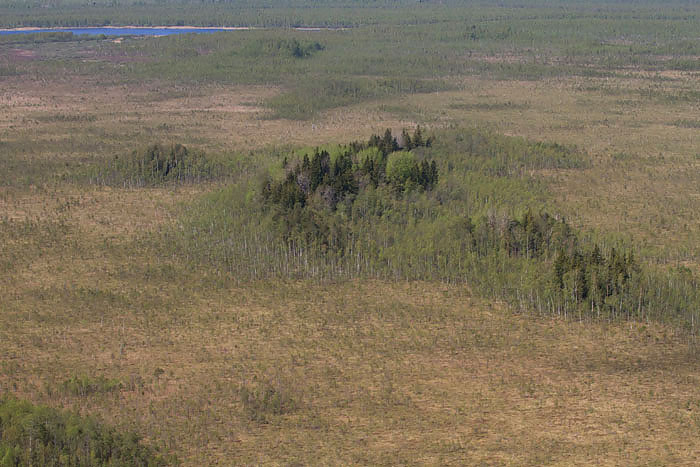Nature
Mires
The River Emajõgi and Lake Peipus have played a big role in developing the landscape here. The River Emajõgi that starts in Rannu-Jõesuu from Lake Võrtsjärv and flows into Lake Peipus in Praaga flowed actually in the opposite direction after the ice age – from Lake Peipus to the larger Lake Võrtsjärv. The current direction of the flow from Lake Võrtsjärv to Lake Peipus developed only 6,000–7,000 years ago.
Emajõe-Suursoo emerged above the ancient Bay of Peipus. The reason for this occurrence, for it becoming a mire, is the water in Lake Peipus that slowly flows in the southern direction due to the rising ground. The surface of the mire is usually only 1–2 metres higher than the average water level of Lake Peipus. There are about 80 mineral (bog) islands in the maremma that have developed from sandy beach ridges and eskers. Most of the old beach ridges are buried underneath a peat layer. All three stages of bog development are represented in the reserve: most common are low-lined mire, then transitional mire, from which Jõmmsoo, Varnja and Pedaspää are the most known, and there is also one bog, Meerapalu.
2%20220517%20Muusikus.jpg)

Hare’s tail cottongrass. Ingmar Muusikus
Rivers and lakes
The River Emajõgi, its tributary Lake Ahja and distributaries Koosa and Kalli divide the maremma into different bog areas by age and appearance. The rivers have a small stream gradient, are deep, enlarged like a lake at places and the direction of the flow changes at some sections depending on the water level in Lake Peipus.
There are 8 lakes in the maremma, the largest of them are Lake Koosa (282.7 ha) and Kalli (198.7 ha). The rest are bodies of water with an area under 100 ha. The lakes have a muddy or peaty bed, are up to 2 metres deep and contain lots of vegetation. All of the lakes connected to the rivers and Lake Peipus are valuable spawning grounds for the fish of Lake Peipus.
In April-May, the water level of Lake Peipus rises up to 0.7 metres because of melt water, which causes an area of 7,000 ha to be flooded in the maremma. Only Meerapalu marsh and higher bog islands reach out of the water during the peak of the water level in Lake Peipus.
.%20Emaj%C3%B5e%20Suursoo%20Peipsiveere%20210517%20Muusikus.jpg)

Mosaic landscape with lakes and bog island's. Jan Siimson
Biota
The biota in the reserve is characteristic to an unaltered natural scenery. The large and almost deserted area is a valuable nesting and stopping spot for water and marsh birds. At least 176 bird species have been seen in the reserve, 77 of them are under protection. The birds connected to our landscape – the white-tailed eagle, osprey and golden eagle – nest here, but also the black grouse, spotted crake and Eurasian bittern. It is known from earlier that the greater and lesser spotted eagle nested also in the reserve.
Approximately 40 mammal species can be seen in the Peipsiveere Nature Reserve, the most common of them the elk, wild boar, European roe deer, red fox, raccoon dog, European pine marten, grey wolf and lynx. The brown bear lives in the reserve by Lake Järvselja. From the mammals connected to water, the Eurasian water shrew, European water vole, beaver, Eurasian otter and American mink live here.

Elk. Ingmar Muusikus.
The special type lakes and rivers in the reserve are important spawning grounds and habitats for 35 fish species. The most common of them are the common and white bream, common roach, ide, European perch, zander, Eurasian ruffe and northern pike. From the protected species, the asp, wels catfish, spined loach, European weatherfish and European bullhead are represented here. Fishing in the reserve is restricted during the spawning period and in the spawning grounds of some species.
In the Peipsiveere Nature Reserve, including the Piirissaar Island, nine amphibians have been found, the rarest of them are the common spadefoot and the European green toad. The European green toad was last seen in 2006 though. From the reptiles, the Eurasian viper, grass snake and common lizard live here, also from the protected species, the broad water-beetle (Dytiscus latissimus), water beetle (Graphoderus bilineatus), conifer bark beetle (Boros schneideri), yellow-spotted whiteface and green hawker.
425 species of vascular plants are known to grow in the reserve, 27 of them have been taken under protection – it is possible to see the rare marsh gentian, leathery grapefern, creeping clubrush, bog orchid, Siberian iris and other protected plants here, for example. The cranberry reserves here are considered to be the largest in Estonia.
Cranberry. Photo: Kaili Viilma